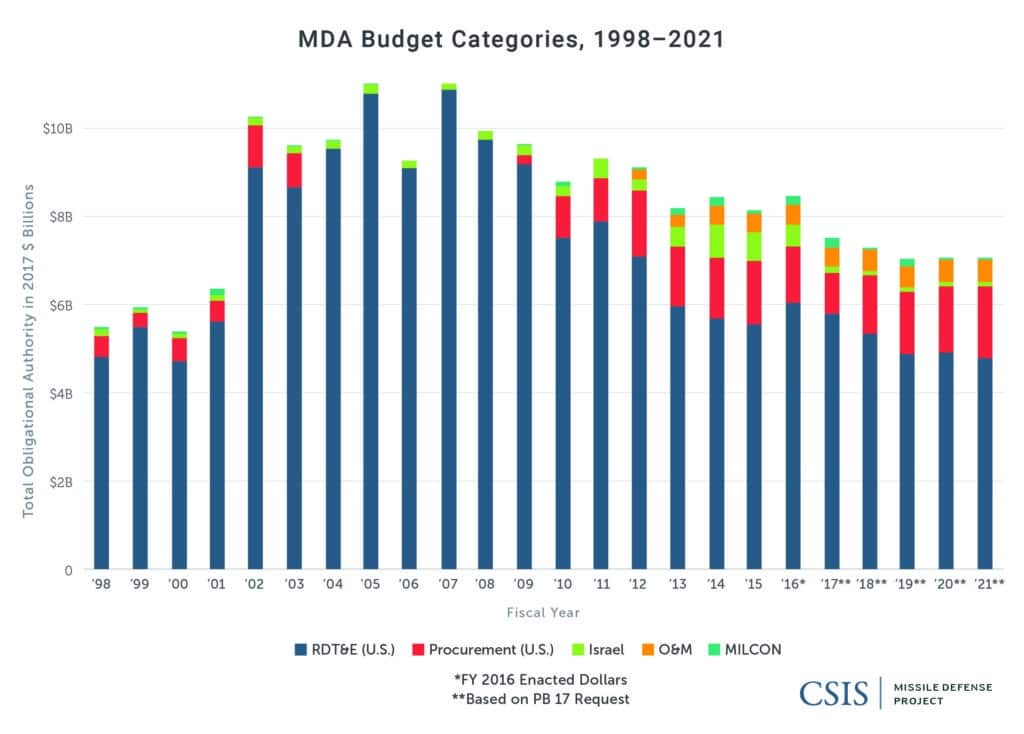The recently released $7.5 billion FY17 budget request for the Missile Defense Agency (MDA) represents an $822 million reduction from last year’s enacted budget. These cuts are essentially divided between procurement ($501 million) and research and development ($322 million) as compared to the $8.3 billion MDA budget enacted by Congress for FY16. While cutbacks to procurement more obviously reduce capacity available to the war fighter, the squeeze on research and development reflects a larger but insufficiently appreciated trend that could impair the ability to outpace foreign missile threats.
Some of the reductions had been projected in the FY16 five-year outlay, which presupposed a FY17 request of $7.8 billion, down from $8.13 billion requested for FY16. Another tranche of cuts, however, was implemented by the November 2015 budget agreement. During his February 9 budget briefing, VADM James Syring, MDA director, noted that MDA’s “share” of the Department of Defense (DoD)–wide $22 billion cut was $300 million, which accounts for the projected $7.8 billion budget being shaved to the $7.5 billion budget unveiled last month. The cuts to the overall DoD budget of $523.9 billion represents a 4 percent reduction; by comparison, MDA’s share represents a 3.8 percent reduction.

Squeeze on RDT&E
One of the larger systemic trends of MDA’s budget, however, is the pressure on research and development, especially within high technology. As missile defense has moved from infancy to adolescence, an increased proportion of MDA’s budget has been diverted from research and development to procurement and operations. The intent had been for MDA to develop the programs and then transfer procurement responsibility to the services, but for the most part this has not taken place.
Whereas MDA and its predecessor organizations had previously been tasked almost exclusively with research and development, the actual operational capability and the failure to transfer procurement to the services have substantially increased MDA’s set of missions. In short, MDA is being asked to do new activities—procurement, operations and maintenance, and even foreign assistance of sorts—in addition to its primary task of research and development.
These trends are accelerating. Whereas MDA devoted 85 percent of its budget to Research, Development, Test and Evaluation (RDT&E) in 2011, it fell to 69 percent in 2015 and 72 percent in 2016. RDT&E accounts for about 77 percent of the 2017 budget, but this apparent rise may be overstated when taking into account expected future foreign assistance and that some significant procurement-like activities have been relocated to the larger research and development category. Without topline relief for MDA, both procurement and the research and development necessary to outpace future threats will continue to face greater pressure.
One example of how the RDT&E line is under more pressure than meets the eye is the transfer of a procurement line for the Ground-based Midcourse Defense (GMD) Program. Whereas the FY16 budget included $460 million for GMD procurement from 2017 to 2020 related to the Redesigned Kill Vehicle (RKV), that line no longer remains in the 2017 request. These “procurement-like” dollars will presumably come from within RDT&E. While there may be good reasons for this transfer, it is worth noting in order to appreciate the squeeze on other research and development.

Procurement
While the 2017 budget request contained few surprises overall, it also contains some unfortunate limits to both capacity and capability improvements. In his budget briefing, VADM Syring explained that most of MDA’s 2017 budget deal cuts come from regional defense capacity: “where we took risk was in interceptor procurement, THAAD [Terminal High Altitude Area Defense] and Aegis in particular.”
For 2017, the Aegis Ashore site in Poland remains on track, but Standard Missile procurement absorbs $103 million of the budget deal reductions. Besides SM-3 interceptors, however, the budget also cuts Aegis hardware and software. Future year projections furthermore appear not to include procurement for Aegis Ashore Phase III or SM-3 IIA beyond 2018. While the budget thus supports the timeline for the Poland site, this may underrepresent expected future demand for SM-3 IIA procurement outside of Europe.
For THAAD, current funding levels keep the completion of a seventh THAAD battery on track by 2018, but there is still no plan to meet the Army’s stated requirement for nine batteries. Permanent deployments in Guam and potentially in the Republic of Korea will likely further strain THAAD supply in light of increasing combatant commander demand.
Israel Assistance
Another unappreciated way in which MDA will continue to struggle to maintain its research and development focus is with significant demands for what might be called missile defense foreign assistance. As with previous requests, the FY17 request contains notional amounts for Israel, which by way of comparison with past funding is modest for both 2017 and future years. If Congress continues its past course, these numbers will be significantly increased—but from within MDA’s topline and at the expense of other U.S. programs to defend the U.S. homeland and armed forces. While the amount requested for Israeli programs totals $145 million, or 1.9 percent of the MDA budget, missile defense assistance to Israel has in recent years consumed between 5 and 9 percent of MDA’s topline. Unless Congress moves Israeli missile defense foreign assistance to another account, every increased dollar for Israeli missile defense will continue to mean one less for U.S. missile defense, and would likely cut into future research and development.

Homeland Missile Defense
One program taking a substantial cut in the FY17 budget is the Ground-based Midcourse Defense Program, devoted to the defense of the U.S. homeland. As compared to $1.27 billion enacted last year, the FY17 base request is $862 million, a 32 percent reduction of $408 million. Some but not all of that reduction was anticipated: the FY16 request had projected $936 million for GMD’s FY17 RDT&E line. The longer-term effect, however, is seen by comparing last year’s overall future year projection to that from this year: a combined total of $2.7 billion for 2017–2020 in this year’s request, as compared to $3.6 billion in last year’s Future Years Defense Program (FYDP) for the same years.
Importantly, the FY17 budget request keeps on track the Redesigned Kill Vehicle program for GMD, perhaps the single most important current effort for improving U.S. homeland missile defense. The amount budgeted for improved homeland defense interceptors remains flat at $274 million but is expected to increase in 2018 to provide for development and later testing. As the means to eventually phase out the CE-1/2 series, the RKV is meant to substantially improve GMD’s overall reliability, which in turn impacts shot doctrine and net capacity for homeland defense. The FY17 budget does include significantly more FYDP for the RKV program, including steady increases for FY18–FY20 as the RKV is tested and perhaps enters production. The amount for improved homeland defense interceptors is projected to increase to $580 million by 2021.
Also included are improvements to allow GMD boosters to select between 2- or 3-stage modes and the continuation of the Long Range Discrimination Radar (LRDR) to be constructed in Alaska. Also notable is $72 million requested to sustain early work on the Multiple Object Kill Vehicle (MOKV), which could be a follow-on to RKV.
During the 2016 budget rollout, MDA made reference to the possibility of an extended range THAAD program. The 2017 request discusses THAAD follow-on capabilities and other upgrades, but it is unclear if an extended-range interceptor is yet moving forward. The Army has continued to emphasize its interest in the program for the Asia-Pacific region and has highlighted the need to acquire an extended-range THAAD interceptor no later than 2025.
This article was originally published at csis.org.
